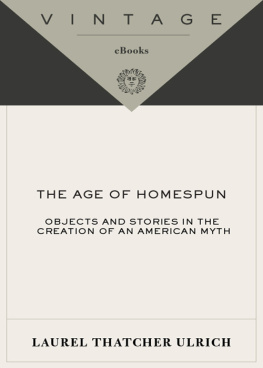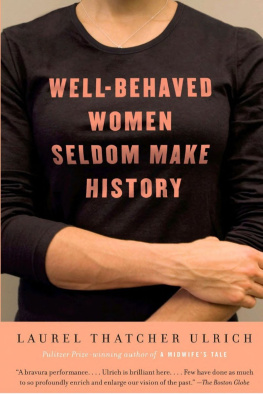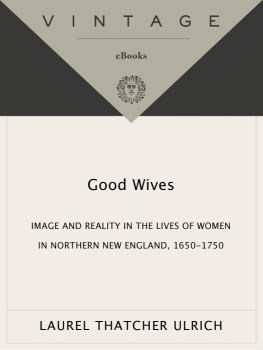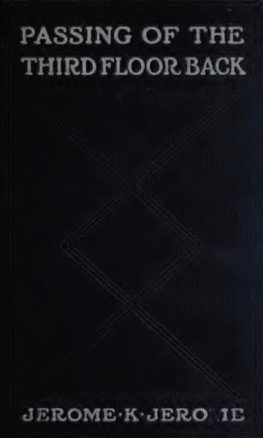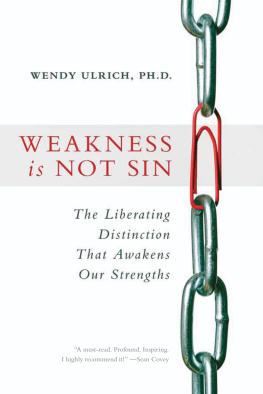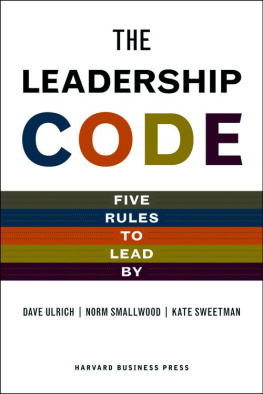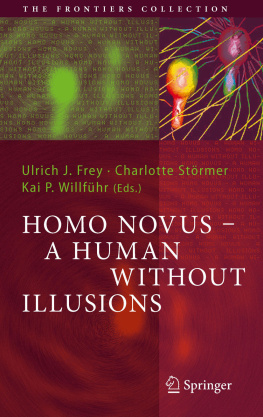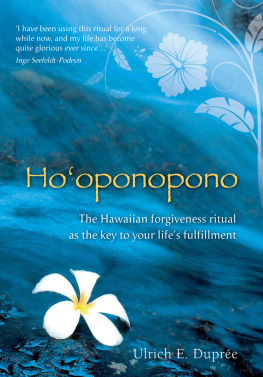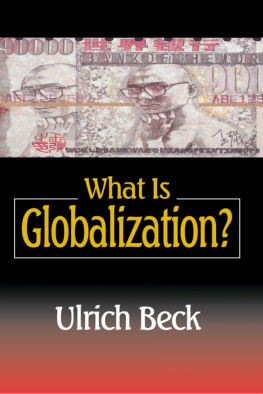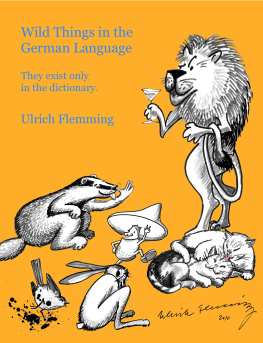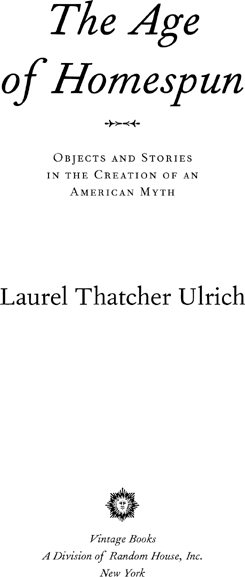ACCLAIM FOR LAUREL THATCHER ULRICHS
The Age of Homespun
Finalist for the Francis Parkman Prize
of the Society of American Historians
Fascinating.A broadening of conventional historical boundaries.
The Boston Globe
In a unique work of astonishing originality, Laurel Ulrich has achieved two distinct goals: re-creating the textiles that early Americans made and used, but also the illusions that nineteenth-century Americans imagined about their forebears domestic milieu. She does all of that with due attention to particularity of place and change over timeproviding a superb example of the gifted historians craft.
Michael Kammen,
author of American Culture, American Tastes
A yarn of a story? A richly woven text? A tapestry of tales? Readers of The Age of Homespun will have to reach deep into their baskets of metaphors to find words to describe this stunning work of scholarship and storytelling, in which Ulrich asks us to think hard about the spinning of wooland the writing of history.
Jill Lepore, author of The Name of War:
King Philips War and the Origins of American Identity
With her usual magic, Laurel Ulrich finds the world in small pieces of evidence. Slavery, Indians, international commerce, class, revolution, gentilityall are woven into the fabrics she describes. Moreover, she finds these weavers, spinners, and embroiderers creating a culture of homespun later to be memorialized in the formation of American identity.
Richard L. Bushman, author of The Refinement of America
A rich blend of history and material culture and of history and memory that reflects the storytelling and analytic skills of one of todays finest historians.
Thomas Dublin,
author of Transforming Womens Work:
New England Lives in the Industrial Revolution
A deeply intelligent, richly detailed study that enriches fundamentally our understandings of early American history and American historical memory.
Neal Salisbury,
author of Manitou and Providence: Indians, Europeans,
and the Making of New England, 15001643
Laurel Thatcher Ulrich
The Age of Homespun
Laurel Thatcher Ulrich is Phillips Professor of Early American History at Harvard University. Formerly a professor of American history at the University of New Hampshire, she is the author of Good Wives (1982) and numerous articles and essays on early American history. She won the Pulitzer Prize for History in 1991 for A Midwifes Tale: The Life of Martha Ballard, Based on Her Diary, 1785-1812. Born and raised in the Rocky Mountain West, she has lived in New England since 1960. During her tenure as a MacArthur Fellow, she assisted in the production of a PBS documentary based on A Midwifes Tale. Her work is also featured on an award-winning Web site called dohistory.org. She and her husband, Gael Ulrich, are the parents of five grown children.
ALSO BY LAUREL THATCHER ULRICH
Good Wives: Image and Reality in the Lives
of Women in Northern New England,
16501750
A Midwifes Tale: The Life of Martha Ballard,
Based on Her Diary, 17851812
All Gods Critters Got a Place in the Choir
(with Emma Lou Thayne)
For all the textilians
You must not go into the burial places, and look about only for the tall monuments and the titled names. It is not the starred epitaphs of the Doctors of Divinity, the Generals, the Judges, the Honourables, the Governors, or even of the village notables called Esquires, that mark the springs of our successes and the sources of our distinctions. These are rather effects than causes; the spinning-wheels have done a great deal more than these.
Horace Bushnell, The Age of Homespun, 1851
Our fathers wrung their bread from stocks and stones And fenced their gardens with the Redmans bones.
Robert Lowell, Children of Light, 1944
What did they do, our grandmothers, as they sat spinning all the day? Are we not ourselves the web they wove?
Anonymous toast, Mary Floyd Talmage Chapter
Daughters of the American Revolution
Litchfield, Connecticut, 1910
Contents
Introduction: The Age of Homespun
L ITCHFIELD , C ONNECTICUT, 1851
1.An Indian Basket
P ROVIDENCE , R HODE I SLAND, 1676
2.Two Spinning Wheels in an Old Log House
D OVER , N EW H AMPSHIRE, DATE UNKNOWN
3.Hannah Barnards Cupboard
H ADLEY , M ASSACHUSETTS, 1715
4.A Chimneypiece
B OSTON , M ASSACHUSETTS, 1753
5.Willie-Nillie, Niddy-Noddy
N EWBURYPORT , M ASSACHUSETTS, AND N EW E NGLAND, 1769
6.A Bed Rug and a Silk Embroidery
C OLCHESTER AND P RESTON , C ONNECTICUT, 1775
7.Molly Ockets Pocketbook
B ETHEL , M AINE, 1785
8.A Linen Tablecloth
N EW E NGLAND IN THE EARLY REPUBLIC
9.A Counterpane and a Rose Blanket
K ENNEBUNKPORT , M AINE, AND N EW E NGLAND, 1810
10.A Woodsplint Basket
R UTLAND , V ERMONT, AFTER 1821
11.An Unfinished Stocking
N EW E NGLAND, 1837
P ROLOGUE

I f this book were an exhibit, I could arrange it as a room, one of those three-sided rooms you sometimes find in museums, open on one side like a dollhouse, with a little fence or rope across. My room wouldnt represent a time or place but an ideaNew Englands age of homespun.
On the left wall, above the paneled fireplace, I would hang a fanciful embroideryeighteenth-century Americans called it a chimneypiece showing courting couples, winsome lambs, and an apron-clad maiden spinning with a drop spindle. On the opposite side of the room, on the curtained bed, I would arrange a real object of homespun, a blue and white bed rug made in Connecticut during the Revolution. Hannah Barnards cupboard would stand against the middle wall, one drawer open to reveal a folded counterpane and a rough wool blanket embellished with a bright pink rose. Between the fireplace and the cupboard, I would stand two spinning wheels, one for flax and one for wool, scattering other emblems of household industry around them, a niddy-noddy partly wound with yarn, a weavers shuttle, and a woodsplint basket filled with unspun wool. On the tea table in the center of the room, I would spread a homespun cloth with a netted fringe, arranging an embroidered pocketbook beside a little Indian basket twined from basswood and corn-husk. For poignancy, I would add to the wall near the bed Prudence Pundersons somber silk embroidery, The First, Second, and Last Scenes of Mortality. On the chair beneath it, I would drop an unfinished stocking still on its ancient needles.
To a scrupulous eye, my room would seem an improbable assembly of objects from different times, places, and sensibilities, as eclectic as a colonial revival house museum or a New England bed-and-breakfast. There is no arguing with that. But this room isnt meant to represent a moment in time. It is a memorial to the nineteenth-century Americans who saved all these things. Without them, this book would not exist.
I could try it another way. Honoring more modern curatorial practice, I could display each object with its kind, hanging the embroideries in the cool splendor of a textile gallery and exhibiting Hannahs cupboard in a furniture show on a low platform surrounded by other carved and painted chests from the Connecticut River Valley. In such a scheme, the unfinished stocking might have to go into storage, but the baskets could move to an ethnographic museum, joining wampum and a war club from the time of King Philip. The spinning wheels, massed with a hundred others, could introduce visitors to a linear display of textile technology from household to factory, with earplugs required in the mechanized weaving room at the end. In any of these spaces, pull-out drawers, safely encased in Plexiglas, could display flat textiles, like the linen tablecloth, their weave structures easy to see at close range.

